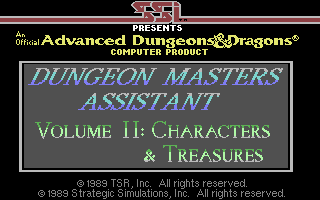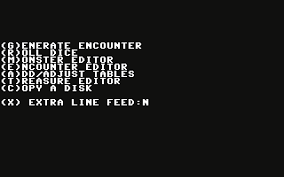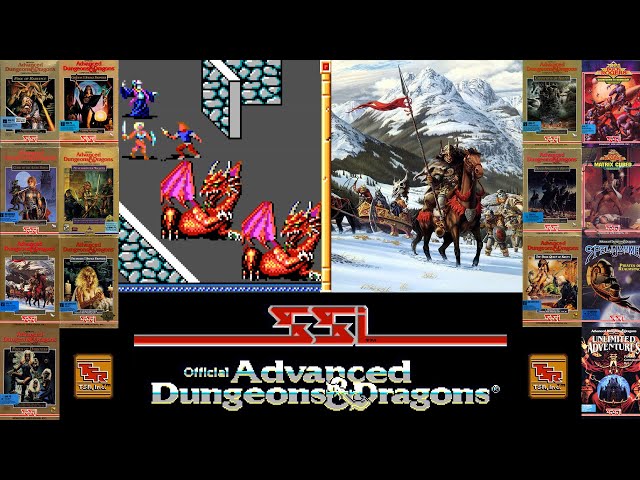

| - | - | - | - | - |
| Dungeons & Dragons | Advanced Dungeons & Dragons | - | Dragon magazine | The Dragon #36 |
In the June 1979 issue of The Dragon (#26), Rick Krebs described
a microcomputer-based system designed
to assist the DM in the more
mundane details of running his campaign. He characterized himself as
“by no stretch of the IMAGINATION a computer scientist, merely a gamer
looking for new ways to USE technology in gaming.” Let me give you
the
viewpoint of 1 computer scientist who has recently discovered
gaming.
The computer is merely a tool. Although it can execute millions of
instructions each second, it can only perform tasks which have been
explained to it in agonizing detail. It is therefore notably lacking
in
creativity. Almost by definition, anything which we understand well
enough to program into a computer is not creative. (The predictions
of a
super chess-playing program, for instance,
have yet to be fulfilled. The
AI researchers discovered that we do not know how
human experts play championship chess.
There are programs which are
excellent chess players, but the top players are still human.) Those
tasks
which we understand fully-especially repetitious clerical tasks—can
often be performed more quickly and accurately by the computer than
by humans. The computer is the ideal drudge.
In the realm of AD&D, a computer can
perform many dull housekeeping
chores so that the DM may concentrate on the creative aspects
of his task. AI research has taught us how to organize
goal-directed games. Computer simulation techniques used in engineering
and economics allow a changing world to
be modeled within
the computer. (See “Zork A Computerized Fantasy Simulation Game”
in the April 1979 issue of Computer. Zork is like single-player
D&D
without role-playing or campaign
background.) Let us consider 8 of
the DM’s tasks and the ways in which standard computer science
techniques might simplify them:
1st, the DM describes the players’ immediate environment to
them. Keeping track of the dungeon map, the
players’ positions on it,
and any changes to the dungeon (forced doors, etc.) is trivial for
the
computer. In fact, a schematic display of the visible room and corridor
layout could be maintained by the computer.
2nd, the DM enforces (or fails to enforce because they are too
much bother) restrictions on Time and
movement.
The inventory of
items carried by each player and their
effect on movement can be
maintained by the computer. Various time-related limitations such as
torch consumption, REST periods, healing,
and spell duration are easily
monitored if the computer is keeping The
Game’s master clock.
3rd, probabilistic outcomes (combat
results, saving throws, wandering
monsters, etc.) decided by the DM depend upon dice throws and
tables. It is easy to program a random-number generator to simulate
any
combination of dice; all the many tables (combat,
armor,
etc.) may be
stored in the computer. This would SPEED up melee
immensely.
4th, the DM is responsible for unintelligent monsters
and subservient
allies and hirelings. Those monsters
and NPCs
who simply attack, retreat, or follow orders can be controlled by the
computer. (A gelatinous cube
does not require much attention from the
DM during an encounter. )
5th, the DM operates the intelligent monsters
and NPCs.
When negotiation, trickery, or flexible response are required,
the DM draws on decades of social experience which cannot be
programmed into any computer. Given the numerical information from
the Monster Manual, however, the
computer can randomly generate
monsters or henchmen and keep track
of their HP while the DM
directs their behavior. Like other tabular information, the monster
characteristics need only be entered once when the program is written.
Variations can be made at any time at the DM’s discretion, of course.
6th, the DM designs the layout of the dungeon and places treasures,
traps, and monsters within it All of these can be generated
randomly under constraints imposed by the DM (total size, average
corridor length, average treasure value and monster strength for each
level, etc. ). For the solo player, automatic dungeon creation would
be a
real boon. Unfortunately, a machine-created dungeon lacks the fiendish
ingenuity provided by a human DM. In practice, I would expect the DM
to design critical areas and let the computer flesh out the dungeon
or to
edit a randomly generated dungeon to create a more interesting setting.
As users of office word-processing equipment know, just having information
stored in the computer makes it infinitely easier to change
things—especially if you have a video display screen.
Seventh, the DM must create the culture and terrain in which the
campaign takes place. Not having read Tolkien, Leiber, or Vance, a
computer can contribute little here besides randomly generated names.
(Computers can tell stories or converse like Freudian analysts, but
they
usually do it by randomly selecting items from their limited store
of
cliches. Just like humans, when they have no real knowledge of a
subject they resort to b.s. )
Eighth, the DM is the referee and final arbiter for the campaign. The
computer can keep track of monsters killed and treasure gained, but
all
advancement decisions and player disputes requiring judgment are the
responsibility of the DM.
The computer can take over many burdensome and repetitious
housekeeping chores, thereby speeding up play and freeing the DM for
his more challenging and creative tasks. One interesting possibility
is
that with enough help from the computer the DM might be far less
reluctant to let the party split up temporarily. At present it is not
really
practical for the DM to run several scenarios at once. There are also
very
good reasons discussed in the AD&D manuals why splinter
groups may
be bad for the campaign. If, however, those leaving (or cut off from)
the
main party are willing to accept less of the DM’s personal attention,
the
computer may be able to keep their part of the dungeon operating until
they are reunited with their fellows.
So why don’t I have all these wonderful aids running in my living
room? The answer is money, of course. Rick Krebs somehow managed
to shoehorn his program and tables into a microcomputer with only
4,096 characters of memory. His program was written in BASIC, a
programming language too weak for an extensive project His microcomputer
cost a few thousand dollars at most In contrast, artificial
intelligence programs are usually run in a sophisticated language,
such
as LISP, on a machine having hundreds of thousands of characters of
memory and costing hundreds of thousands of dollars. This means that
the sophisticated techniques which are the fruits of decades of research
are not applicable to a machine that the average gamer or group of
gamers can afford.
The situation is improving rapidly, however. The next generation of
microcomputers will sell for a few thousand dollars but have most of
the
capabilities of the previous generation of large computers. Sophisticated
languages such as Pascal and LISP, formerly available only on large
machines, are now available even on microcomputers. There is a
growing realization that a microcomputer can do almost anything a large
machine can do—only more slowly. Since a significant percentage of
computer science students have grown up on fantasy and science
fiction, you can expect to see some very powerful AD&D aids
in the next
few years.
As an example of what can be done now, consider the problem of
describing the adventurers’ surroundings to them. Ideally, one might
like to display the visible area of the dungeon, the adventurers, and
the
monsters on a color television screen. Realistically, enough resolution
to
draw the characters well and enough speed to allow even cartoon-like
movement are prohibitively expensive. Painted figures give much more
realism than could be afforded with a fully animated dungeon.
Nevertheless, available displays do have enough resolution to easily
depict the rooms and corridors, if not the characters and items within
them. The Apple II microcomputer, for example, has a simple color
graphics capability. An option allows display on any color television.
Large-screen projection televisions have been available for years now.
Why not place standard painted figures in their marching order on a
table and project the dungeon around them? As the adventurers move
through the dungeon, the projection could be made to advance and
turn around the stationay miniatures. Special mounting would be
needed to direct the projection onto the horizontal surface, but the
whole system could be bought for less than the price of a car. Its
two
major components, the microcomputer and the television, would be
available for their normal functions. Having a clear visual display
of the
adventurers’ surroundings would enhance the realism of the fantasy.
Retaining the use of miniatures would preserve that artistic aspect
of
gaming, as well as keep the system cost within bounds.
Although we can expect some fantastic playing aids in the near
future, a note of caution is in order. Since the computer is intended
to be
the DM’s assistant, the interface between DM and computer must be
very carefully designed. If the DM spends all of his Time
typing data into
the machine and muttering at his private DISPLAY screen, the players
will
become bored and leave. The computer must be FAST, unobtrusive, and
completely subservient to the DM.

OUT ON A LIMB
‘Computer freak’
To the editor:
I have just purchased TD #36 and I fell that it
is time I wrote and told you how much I enjoy the
magazine. I especially like the new series, The
Electric Eye. As a computer freak and a game
freak I can see how the two go together so well.
I think an article on the more unusual weapons
would be interesting. There are several
that I would like to see in our campaign such as a
bola, net, garotte, whip, boomerang, etc.
Is there an updated version of the Monster
Manual in the works? Or at least
a collection of
the new monsters from Dragon’s Bestiary? The
latest, the Krolli, is a beauty.
Michael E. Stamps
(The Dragon #39)
According to our recently compiled index of
all TD articles (to be published in TD-40),
there
has not been a “table of bonuses jot each monster”
printed in the magazine. Michael’s friend
may be referring to the alphabetical list of creatures
from the Monster Manual which
is printed
as an appendix in the Dungeon Masters
Guide. <this data has been moved to the MM>
As for Michael’s request for an article on unusual
weapons, all we can do is pass on that sentiment
(by publishing this letter) and hope that some
energetic reader will take advantage of the opportunity
to send us an article on that subject.
Yes, there is another monster book in the
works. The Fiend Folio is being
produced by
TSR Hobbies, Inc., and will be available later <TSR UK>
this year. The project is out of The Dragon’s
domain, so we can’t say exactly what it will contain.
At the present time, we have no plans to
reprint Bestiay creations in a single volume—
but who knows what the future will hold?
—Kim
(The Dragon #39)
